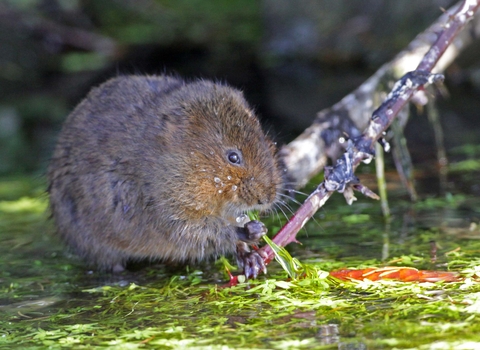
Terry Whittaker/2020VISION

©Margaret Holland
Water vole
Scientific name
Arvicola amphibiusWhen to see
January to DecemberSpecies information
Category
Statistics
Length: 14-22cmTail: 9.5-14cm
Weight: 150-300g
Average lifespan: 0.5-1.5 years
Habitats
About
The water vole lives along rivers, streams and ditches, around ponds and lakes, and in marshes, reedbeds and areas of wet moorland. Look out for the signs of water voles, such as burrows in the riverbank, often with a nibbled 'lawn' of grass around the entrance.Water voles like to sit and eat in the same place, so piles of nibbled grass and stems may be found by the water's edge, showing a distinctive 45 degree, angled-cut at the ends. 'Latrines' of rounded, cigar-shaped droppings may also be spotted. Water voles start to breed in spring, having three to four litters a year of up to five young.
How to identify
The water vole has chestnut-brown fur, a blunt, rounded nose, small ears, and a furry tail. It is much bigger than other vole species. Scotland’s water voles often appear darker, with many having a black coat.The similar brown rat is larger, with grey-brown fur, a pointed nose, large ears that protrude from its fur, and a long, scaly tail.
Distribution
Still widespread throughout mainland UK, though range and numbers have significantly declined. Absent from the Channel Islands, Isles of Scilly, Scottish islands, Northern Ireland and the Isle of Man.In our area
Recent surveys by Warwickshire Wildlife Trust found a small number of water voles have come back to North Warwickshire. This area is now a really important part of a network of canals, rivers and brooks where vital work for water voles is underway.
Warwickshire Wildlife Trust Work is improving habitat for water voles, enhancing the river and canal bank habitat to help water voles move freely, with more nesting and feeding opportunities. Where canal edges are concreted or lined with metal the Trust is creating platforms and ladders to help water voles get out to feed. This includes trialling new ‘water vole motels!’ These are chestnut posts lined with stock-proof fencing and coir matting, planted up with tasty plants for water voles. They resemble semi-aquatic hanging baskets!
Training has also been provided for local people to help preserve these valuable waterways and water vole populations. However further funding is now urgently needed to continue this vital work and allow us to:
- Survey how good the habitat is and check for water voles
- Enhance habitat and improve links between waterways to encourage water voles to spread into other waterways.
- Give water voles more cover to escape predators
- Monitor American mink to make sure numbers are as low as possible to prevent them wiping out water vole colonies
- Provide training opportunities and run volunteer groups in local communities
Did you know?
The water vole is famously known as 'Ratty' in Kenneth Grahame's classic children's tale, The Wind in the Willows. Despite being sometimes referred to as a 'water rat', there is no such thing - there are brown rats, black rats and water voles.Recent surveys by Warwickshire Wildlife Trust found a small number of water voles have come back to North Warwickshire. This area is now a really important part of a network of canals, rivers and brooks where vital work for water voles is underway.
Warwickshire Wildlife Trust Work is improving habitat for water voles, enhancing the river and canal bank habitat to help water voles move freely, with more nesting and feeding opportunities. Where canal edges are concreted or lined with metal the Trust is creating platforms and ladders to help water voles get out to feed. This includes trialling new ‘water vole motels!’ These are chestnut posts lined with stock-proof fencing and coir matting, planted up with tasty plants for water voles. They resemble semi-aquatic hanging baskets!
Training has also been provided for local people to help preserve these valuable waterways and water vole populations. However further funding is now urgently needed to continue this vital work and allow us to:
- Survey how good the habitat is and check for water voles
- Enhance habitat and improve links between waterways to encourage water voles to spread into other waterways.
- Give water voles more cover to escape predators
- Monitor American mink to make sure numbers are as low as possible to prevent them wiping out water vole colonies
- Provide training opportunities and run volunteer groups in local communities
